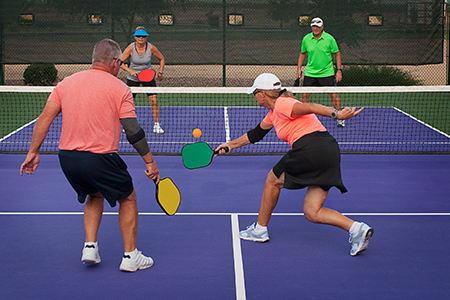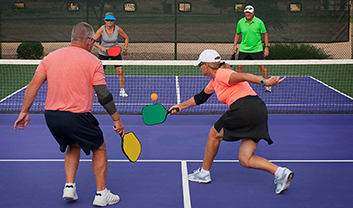
Pickleball is one of the fastest-growing sports in America and is described as a perfect combination of tennis, badminton, and ping pong. Pickleball is a social sport that the whole family can enjoy and is considered a low-impact sport with great physical benefits. While pickleball is all the rage right now, like all sports, players must be aware of potential injuries and how to prevent them.
Common Shoulder Injuries
With all the serves, volleys, lobs, and strikes, the shoulder endures a lot of wear and tear. Below are some of the most common shoulder injuries:
Rotator Cuff Tears: The rotator cuff is a group of muscles that stabilize the shoulder joint. Tears to the rotator cuff are usually a result of overuse. The repetitive motion involved in serves, strikes, volleys, and lobs in pickleball increases the likelihood of injury.
Tendonitis: Tendonitis is the inflammation of the biceps tendon or the rotator cuff. It is usually caused by overuse or an acute injury.
Bursitis: This condition occurs when the tiny fluid-filled sacs (bursa) have become inflamed, leading to pain and redness.
Shoulder Impingement: Shoulder impingement is the inflammation of the tendons of the shoulder joint and is usually caused by repetitive overhead movements.
Common Knee Injuries
Due to quick lateral movements, pivots, and changes in direction, knee injuries are a common occurrence in pickleball. Common knee injuries include the following:
Knee Sprains: A knee sprain occurs when the ligaments are overstretched resulting from a twisting movement or fall.
Meniscus Injuries: Meniscus tears are one of the most common knee injuries. These knee joint “stabilizers” can be injured from sudden twists and changes in direction.
Patellar Tendonitis: The patella is the tendon that connects your kneecap to the tibia. This tendon can become inflamed from overuse or a sudden jump, twist, or fall injury.
Prevention Strategies
If you want to continue to enjoy the sport of pickleball, injury prevention is essential. Consider implementing the following injury prevention strategies:
Warm-Up and Stretch: Always include a warm-up as part of your routine. Incorporate some static and dynamic stretching. Ensuring your muscles are warm is key to injury prevention.
Wear Proper Footwear: Quality footwear can protect you from injury. It is worth the investment to get a good pair of court shoes that have plenty of grip and support.
Stay in Shape: Many pickleball injuries occur as people jump back into the sport after months of no exercise. Stay active in the off-season by doing other activities you enjoy.
Strength Training: Strength training builds your muscles which helps to reduce the risk of overall injury. Stronger muscles also provide your bones with the nutrients they need to stay strong. Strength training should be done at least three days a week.
Practice Good Form: Proper technique is key to injury prevention. Work with a coach, physical therapist, or any healthcare professional who can assist you to ensure you have proper form.
Consume a Healthy Diet: Hydration and nutrition are key to a healthy lifestyle but also vital to injury prevention. You need a diet full of lean protein, fruits, vegetables, and whole grains. Always drink plenty of water to keep your muscles hydrated while playing.
Pickleball is an incredible sport that can keep you active and in great shape for years to come. Following the injury prevention steps above can help you stay safe and injury free while you play.
Dr. Kai Mithoefer is board-certified in both Orthopedic Surgery and Orthopedic sports medicine specialist. Dr. Mithoefer is an internationally recognized specialist for complex shoulder and knee injuries with over 15 years of experience with the treatment of sports-related injuries. Dr. Mithoefer practices at Boston Sports and Shoulder Center and has published more than 100 scientific articles and book chapters and is a frequent speaker at national and international orthopedic meetings.











